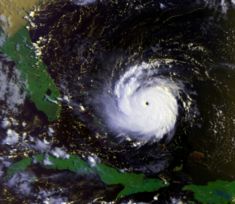Report: Hurricane Model a Man-Made Disaster
 The catastrophic Hurricane Katrina drowned New Orleans during the summer of 2005 and caused more than $40 billlion in damage. But Katrina did not damage the financial structure of America’s property insurance system as much as what a Florida newspaper is describing as a man-made disaster which occurred a few weeks later in Bermuda.
The catastrophic Hurricane Katrina drowned New Orleans during the summer of 2005 and caused more than $40 billlion in damage. But Katrina did not damage the financial structure of America’s property insurance system as much as what a Florida newspaper is describing as a man-made disaster which occurred a few weeks later in Bermuda.
In a 10-page “Sarasota Herald Tribune” special report headlined “Florida insurers rely on dubious storm model”, it’s claimed the decision by global insurers and reinsurers to embrace a new method of hurricane predictions in Bermuda proved to be devastatingly costly both to the industry and consumers.
“Risk Management Solutions a multimillion-dollar company that helps insurers estimate hurricane losses and other risks, brought four hand-picked scientists together in a Bermuda hotel room,” reports the newspaper. “There, on a Saturday in October 2005, the company gathered the justification it needed to rewrite hurricane risk. Instead of using 120 years of history to calculate the average number of storms each year, RMS used the scientists’ work as the basis for a new crystal ball, a computer model that would estimate storms for the next five years.
“The change created an $82 billion gap between the money insurers had and what they needed, a hole they spent the next five years trying to fill with rate increases and policy cancellations.
RMS continues to argue the change that drove Florida property insurance bills to record highs was based on “scientific consensus.”
“The reality was quite different,” argues the Florida newspaper, which has run a number of highy critical reports on the role Bermuda-based insurers and reinsurers have reputedly played in driving up premiums for home and business insurance in the hurricane-ravaged state. “Today, two of the four scientists present that day no longer support the hurricane estimates they helped generate. Neither do two other scientists involved in later revisions. One says that monkeys could do as well.
“In the rush to deploy a new, higher number, they say, the industry skipped the rigors of scientific method. It ignored contradictory evidence and dissent, and created penalties for those who did not do likewise. The industry flouted regulators who called the work biased, the methods ungrounded and the new computer model illegal.”
Florida homeowners would have paid more in premium costs even without RMS’ controversial new model, the newspaper concedes. The disastrous impact of Katrina, which killed more than 1200 people, had already convinced insurers and reinsurers that Atlantic hurricanes were becoming larger and more deadly.
“But it was RMS that first put a number to the increased danger and came up with a model to justify it,” claims the newspaper. “As a result of RMS’ changes, the cost to insure a home in parts of Florida hit world-record levels. Hundreds of thousands of homeowners were forced to find new insurers as national carriers fled the state.”
Yet the prediction of more dangerous hurricane seasons in Florida have not been borne out, says the newspaper.
“The new RMS model called for at least 11 hurricanes to come ashore in the United States by the end of 2010, most of them aimed at Florida,” it reported. “Four hurricanes struck the US. None hit the Sunshine State.”
California-based RMS continues to promote its short-term model as the preferred option for customers in the insurance and reinsurance industries. The “Sarasota Herald-Tribune” say it remains the preferred model for Bermuda reinsurers, the most crucial source of private hurricane protection for Florida.
Read More About
Comments (3)
Trackback URL | Comments RSS Feed
Articles that link to this one:
- Bermuda Weekend News Photos Videos November 2010 | Bernews.com | November 15, 2010


If they hadn’t stupidly build an entire city below sea level, then there’d have been hardly any damage. So it was a man made disaster – absolutely.
Perhaps future city planners can dodge a bullet next time by building a bit higher — like above sea level – DUH!
@Just Me Thinking, this article is talking about Florida. The city you are talking about is New Orleans which in Louisiana.